back
to my homepage
JH. 20-pole Phaser
inspired by Aries, ARP and Tau circuits
A redesign of the Tau "The Pipe"
Flanger - actually, a Phaser, using 20 (twenty!) all pass filter stages
- getting rid of obsolete components, and including the parts of the
originally potted modules to the main printed circuit board.
If you haven't heard the original yet, go to
http://www.keyboardmuseum.org/soundsheet/soundsheet.html
(external link);
scroll down to "The Pipe Phase Demo Record" and listen to the demo.
The service manual is located here:
http://www.musicsynthesizer.com/Diode%20Phaser/Diode%20Phaser.html
(external link);
I think it's quite impressive and extreme sounding, and it's closely
related to the ARP Quadra Phaser which I've cloned some years ago:
../additional_schemos.html
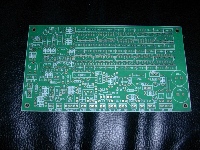
Picture of bare printed circuit
board
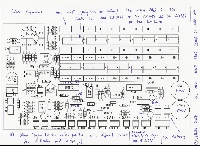
Component Overlay
with comments (updated)
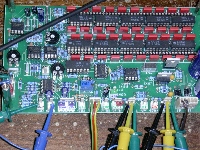
Finished board with CA3046s
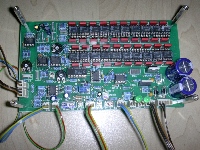
Finished board with LM394s
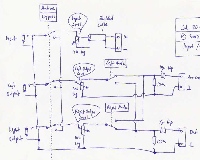
Audio signal and control
voltage connections (several options shown) (272k PDF file)
Sound demos (mp3
format) are available (external links):
http://electro-music.com/forum/phpbb-files/jh_tau_demo_1_115.mp3
(White noise, and single VCO saw wave gated by Trapezoid, from Synthi
Clone.
Run thru the Tau, added a little bit of reverb, recorded with
Tracktion.)
http://electro-music.com/forum/phpbb-files/jh_tau_demo_2_korg_drums_181.mp3
(Two stupid drum patterns from my Korg Electribe.)
http://electro-music.com/forum/phpbb-files/jh_tau_demo_3_lambda_clavi_161.mp3
(Me playing the Clav sound on the Korg Lambda and my 5-year-old son
Tassilo
turning the knobs of the Phaser.)
http://electro-music.com/forum/phpbb-files/jh_tau_demo_4_lambda_strings_604.mp3
(Lambda Strings, also with Tassilo on the Phaser knobs)
Schematics
Page 1: Audio Signal Path
(27kB PDF)
Page 2: All Pass Filter
(23kB PDF)
Page 3: Control Circuit
(21kB PDF)
Page 4: Power Supply (14kB PDF)
Page 5: Connections (Basic Version)
(17kB PDF)
Some other Options for
Connections (272kB PDF)
Bill Of Materials
I've made a BOM for the components that
are soldered directly to the board. (For off-board components, please
check the schematics for the various options.)
I just listed the parts and made some remarks; but Bill
and Will Hall are composing a BOM that includes references where to
buy the parts, with a focus on US shops.
They are also including switches and pots and jacks in their list.
Important
update:
I noticed that the 100nF 0805 SMD bypass capacitors that I've soldered
into my prototype are only rated for 25V.
What you need, by any means, are 35V (or higher) rated capacitors.
While ordering new caps from Reichelt, I noticed that for 0805 parts,
the 100nF come in 25V, but the 47nF are rated 63V.
So I ordered a bunch of 47nF/63V 0805 caps for future use in my
electronics lab.
Bottom line for you:
If you
can actually get 0805 parts 100nF with 35V or more, it's fine to use
these.
If not, go for
47nF with 35V or more.
Options
and
Modifications
Different Transistor Arrays (click on pictures to
enlarge)
Using CA3046 transistor Arrays
(recommended)
|
Using LM394 Transistor Pairs
(expensive!)
|
Tested with CA3046. Should also
work with:
CA3086, LM3046, or similar
|
Tested with LM394. Should also
work with:
SSM2210, MAT-01, MAT-02, or similar
|
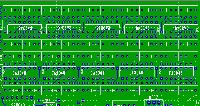
|
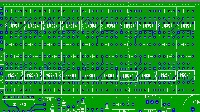
|
Note
the different orientation of the ICs for both versions, and also for
upper and lower row in both versions!
Tempco Resistors
My version of the 20-pole-Phaser was designed with a 560 Ohm
Tempco Resistor for Temperature compensation of the 1V/Octave tracking.
(The Tau "Pipe" Phaser used a 1.87 kOhm Tempco Resistor.)
You can use a 1 kOhm Tempco Resistor, which is a much more common
value, if you also change two other component values.
This picture shows what you have to
change. (Or click on image to enlarge.)
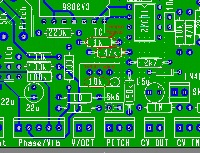
Modular Systems? Using a +/-15V Power Supply ...
The PCB has an onboard power supply and creates stabilized
positive and negative voltages (+15V and -15V) from a 18V AC voltage.
However, if you want to integrate the board into a Modular System like
MOTM or others, which already have a +/-15V Dual Supply voltage
available, you can modify the Phaser Boards to use this directy.
In fact, you don't need a lot of components - you just omit them on the board. (Do not use the Phaser on a +/-15V
supply with these components
soldered in! This will result in severe damage of the Phaser, or the
Modular synth, or both!)
On a Board without these components, solder two wire connections (use
insulated wire!), as shown in this
picture.
Re-label the 18V AC connector for
the use of +15V and -15V. (glue some tape over the original silkscreen,
to avoid confusion, and severe damage from wrong connections.)
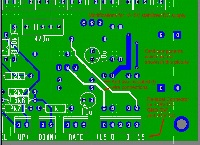
I know these questions will come, so I tell you right now:
There is no standard power connector provided for ony of the commercial
modular systems - you have to connect some wires directly, or build an
adapter.
Other voltages, like +/-12V, are not
supported. (You can try to run the modified
board on +/-12V, and report the results back to me if you like; I
expect it to work somehow,
but the sweep range will most probably not be right. The 1/x function
generator is tricky here!)
Front Panel
There are several people working on front panels for this project, in different form factors.
(If you want tme to add a link to your front panel, please send me a mail.)
Here's what I designed for my own board:
19" 1U front panel
Im using knobs with numbers from 0 ... 10 printed around their skirt
(like some guitar amps have them), so I only need a single marker at 12
o'clock position, instead of tick marks all around the knob.
The front panel is designed to fit into a an enclosure from RS-Components, order number 221-9284 and 224-470.
The switches are push buttons from Maplin - I don't know if they have them anymore.
If you're interested to get the fpd file, please send me a mail. (Right
now, the front panel is untested, so I don't know if the dimensions are
right. You will know that they are tested, as soon as I put up pictures
of the whole effect with enclosure.)
Third
Party Project
Documentation
Two friendly persons, Bill and Will Hall, have mailed me and
volunteered to document the progress of building their phaser boards on
their web site.
They are also working on a Bill Of Materials with focus on American
component suppliers - this will be especially helpful for others in the
USA, because I naturally buy my components in Germany, mostly at
Reichelt and RS-Components. (And most components I don't buy for the
project at all, because I have them in the drawer, and only fill them
up when a certain value is empty.)
Link
to Bill and Will's site
External Links to Sound Samples
Samples from Drew Neumann
(to be continued ...)
back
to my homepage








